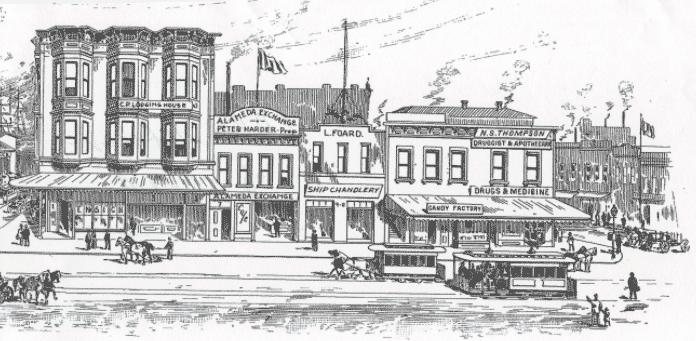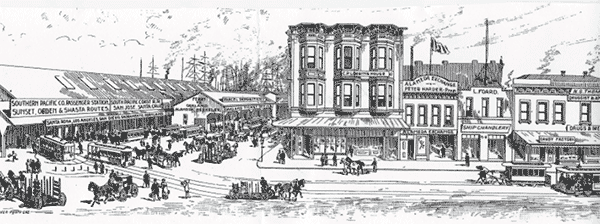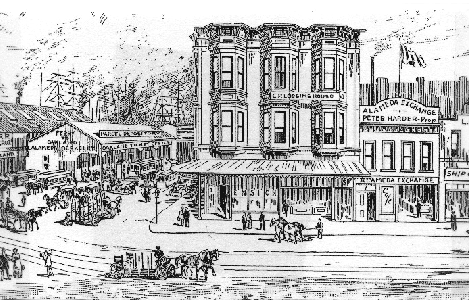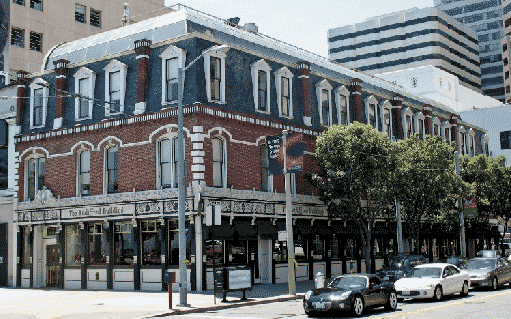2019 PCNS Papers
Table of ContentsFrisco's Old East Street
by Jerry Schimmel
2019 Second PlaceSailor Saloons and Little Brass Checks with side trips to Jackson Street and The Cliff House
“As the city changed shape, so did East Street, but always it remained the waterfront… laced throughout its irregular length by saloons, business houses, crimping joints and restaurants. Soon it became the most dangerous of thoroughfares on stilts as its worm-eaten piles crumbled sending huge loads of lumber into the Bay. By day it was crowded with people of the sea; at night criminals worked from its shadows.”
– Felix Riesenberg, Jr. describing East Steet of the 1860s.Nowadays we know East Street as The Embarcadero, a name assigned by San Francisco Supervisors in 1909 sixty years after the Gold Rush. The four-and-a-half mile, often gridlocked boulevard is divided these days by light rail tracks and features a scenic promenade by the water. Locals and visitors can bicycle, scooter, walk, or linger where sailors and stevedores once belayed windjammers to bollards, off-loaded bales of jute, and went three sheets to the wind when enough silver jingled in their pockets.
The word “Frisco” in the title is an oft-scorned alternative to the city’s official name. Its mention during present-day conversations can bring forth an energetic and often irksome disapproval of the speaker. During the 19th Century and a decade or two after, the word was common among the working classes and sailors who couldn’t get their mouths around the official name.
Saloons on East Street were profoundly affected by two major events: The Earthquake and Fire of April 1906, which destroyed the northeast section of the city, and the National Prohibition Act of January 1920, which shut down sales of alcoholic beverages. Historians might include a third, the Valentines’ Day 1917, closing of the city’s brothels. Even though the main red light district was a dozen blocks from East and Market it was always happily patronized by mariners after months at sea.
Brass Checks
East Street’s saloonkeepers were ready users of brass checks though some employed tokens struck in other metals. These “pledges of value” served as credit pieces when dispensed by bartenders and proved first-rate for dropping into bartop slot machines as well as the other new technology, telephones. Sometimes customers forgot to redeem them the result of which was extra income for saloonkeepers. By the 1890s metal checks were employed nationwide by thousands of enterprises, their heyday in California lasting until Prohibition. A few are described here accompanied by noteworthy accounts of their circumstances.
(Note the letters “mm” in reference to the tokens discussed below. They stand for “millimeters” and in this case refer to the diameters of tokens.)
The Ferry Building
San Francisco’s Ferry Building and clock tower were planned by architect Arthur Page Brown, his two-block structure opening to travelers in 1898. The new terminal soon turned into one of the world’s busiest transit centers with upwards of 50,000 commuters a day until the vehicle bridge to Oakland opened in 1936. Today modern ferries shuttle back and forth from San Francisco serving a dozen communities around the bay.
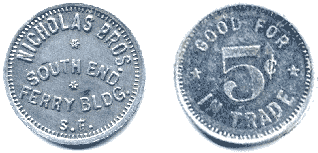
There was only one token I located with a Ferry Building address, an aluminum piece with a 24mm diameter announcing Nicholas Bros., South End Ferry Bldg.,Good For Five Cents. Phone books for 1928 show “William and J.J. Nicholas Brothers, newsstand.” A year later only “William Nicholas, cigars” was listed through 1946.
South Side Saloons
South of Market Street East Street was given even-numbered addresses; north of Market they were odd. Saloons clustered on the southern landward side between Market and Howard streets. Saloons north of the Market Street cable cars were located one-by-one on the corners of East Street or farther up major streets like Washington, Jackson and Pacific. A few set up shop as far south as Mission Creek near Berry Street where marine repair shops and smaller dry docks were situated. The tokens described here are from south of Market.
The Ensign, 1 Market Street
The Ensign Saloon opened in 1892 at the southwest corner of Market and East streets remaining in place for 28 years until Prohibition brought about its end. Owner names recorded were Schwartz, Husing & Meyer, though nothing is known about them except that after 1906 Husing vanishes from the listings.
In 1896 The Ensign’s doors opened at ground level facing Market Street. Post-1906 photos show The Ensign on the second floor of a three story structure, same address, though its entrance was up a staircase accessible only from East Street. In later days the Ensign was a commuter’s “happy hour” stop before the last boats left for Oakland and Berkeley.
Underneath the Ensign in deep mud lay the rotting hulk of the Rome, a three-masted windjammer abandoned by its crew in 1849, a fate shared with dozens of other vessels when sailors jumped ship and headed for gold country. Nowadays thousands of subway riders unwittingly zip through a tunnel carved in the Rome’s still entombed hull.
The Ensign issued a number of different 21mm brass tokens, all inscribed with Ensign Saloon, 1 Market Street. Shown is one used for outgoing phone calls and labeled Telephone Check on the back. The other is a credit piece, its reverse adorned with a simple 5, exchangeable for a glass of beer or shot of house whisky. The tiny diesinker signature c.a. klinkner & co s.f. indicates it was struck between 1892 and 1898.
A few saloons like The Ensign provided temporary storage for sea bags while sailors waited for the next ship out. For this service brass tags were issued in pairs, usually odd rectangular shapes like the one shown, size 36x41mm. Like tokens the tag displays the words The Ensign, 1 Market St., S.F. with a serial number and blank reverse. One tag was affixed to the bag as it went into the locker and the other kept by the sailor. Woe to the man who lost his tag: no brass check, no sea bag.
The Arrival, Mission and East Streets
In 1902 Fred and Henry Kistenmacher opened The Arrival at 2 Mission Street on the northwest corner of East and Mission. The Arrival was one of few saloons surviving 1906 and continued whetting whistles right up to 1920. Its token was slightly different from most others being struck in a nickel alloy (21mm). Its inscription reads The Arrival,Kistenmacher Bros., East and Mission Sts., Good for 5¢ In Trade, words typical of bar credit pieces.

Fred and Henry dispensed a “bawdy” pocket mirror with a 10¢ cash value, presumably exchangeable for a shot of better whisky than that given in exchange for a token. The mirror is 45mm in diameter with wording printed in black around the main image: The Arrival Bar, cor. East and Mission Sts. S.F. Cal., Good for 10 cts. at the bar.
The ribald part is in the center showing the head of a middle-aged bald man in an early 20th Century shirt collar. When examined closely the face of the head is seen to be the outline of a nude young woman bending backwards. The Arrival like all East Street bars was totally male-oriented where women were often not allowed, not even prostitutes. Sailors seeking an evening’s escort had to walk up to Pacific Street with its raucous side alleys and infamous title, the Barbary Coast.
The Bulkhead, Mission and East Streets
The Bulkhead Saloon occupied the ground floor of the Audiffred Building at 1 Mission Street directly across from The Arrival. A mechanical draftsman named Alpheus Bull launched the saloon weeks before the 1906 fire which it survived and stayed open through 1916. Bull passed away in 1914 and his widow, Daisy, took charge until she could manage a sale.
The actual meaning of “bulkhead” in old time Frisco referred to the seawall along East Street. Sailors rarely used the word, their customary epithet being “bulkhead” which Alpheus wisely appropriated for his drinkery. Two 21mm brass tokens are known showing the single word Bulkhead on the front and Good for 5¢ and 10¢ in Trade on the backs. The 10¢ token has a tiny diesinker’s signature, moise-klinkner, s.f., used briefly around 1912. The 5¢ token sports a design common before 1906.
The Audiffred Building was erected in 1889 by Hippolite D'Audiffret, a Frenchman who settled in Mexico after the failed French occupation of the 1860s. Rescued from the fire of 1906 Hippolite’s building stands today as San Francisco Landmark #7. Some distance behind the Audiffred and deep in the mud lies the hulk of the Othello, like the Rome another ship forsaken in the scramble for shiny yellow stuff.
As legend has it when the 1906 ‘quake hit and flames moved too close, firemen were preparing to dynamite the Audiffred to keep the oncoming inferno from spreading. On receipt of this appalling news the head bartender promised two quarts of whiskey to every fireman and a cart of wine if they saved the building.
While this might sound like a sailor’s yarn, similar acts of alcoholic generosity were reported in connection with other bars and their suppliers. Best known of all was the legend of the Hotaling warehouse with its huge liquor inventory. In this case firemen and sailor volunteers had to drag the hose from a Navy fire boat eleven blocks across Telegraph Hill to Jackson Street.
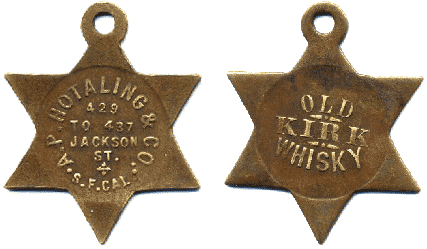
Shown is a curious brass 39mm star-shaped advertising piece which was made to hang on the neck of an Old Kirk Whisky bottle, Old Kirk being Hotaling’s principal brand. The tag’s wording reads: A.P. Hotaling & Co., 429-439 Jackson St., S.F. Cal. and was struck sometime between 1910 and 1915.
If as they say, God spanked the town
For being over-frisky,
Why did He burn His churches down
And spare Hotaling’s whisky?
- Charles Kellogg Field (1873–1948)L F, 128 East Street
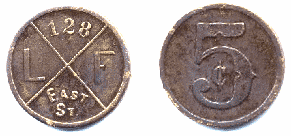
The initials on this uninspired 21mm brass disc stand for Louis Fiedler a waiter, steward and caterer who for a short time in 1909 opened two cigar stands, one at 128 East Street and another on the corner of Fourth and Folsom streets. The interesting parts of this section are not about Fiedler, but the owner of 128 East Street.
Jerome Aloysius Bassity (1875-1921) was proprietor of 128 from 1908 through 1910 and one of San Francisco’s street level scoundrels from the late 19th and early 20th centuries. He was born on the East Coast and grew up on Frisco’s streets with little or no education, a limitation mattering less at the time than it does now. In a few short years he went from being a sixteen year old elevator boy to saloon keeper, brothel owner, and eventually to a wannabe race track owner in Baja California. His political and criminal influence in the city was widespread especially during the mayoralties of Eugene Schmitz (1902-1907) and Patrick McCarthy (1910-1912).
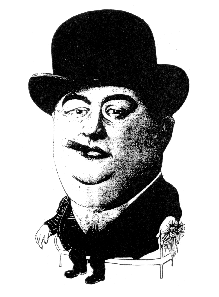
Bassity’s bar at 128 was The Mohawk Saloon though you won’t find the name in directories where it is listed as Bassity Mercantile Company, liquors. Between 1900 and 1906 records show that Bassity owned or ran at least four saloons at one time or another mostly on Market Street and in the Tenderloin. Later he invested in brothels, especially those on the 700 block of Commercial Street noted for architect-designed bawdy houses. With all of his business success few associates would have called Bassity a great guy.
Two of his earliest saloons began business in 1905 at 1100 Market Street and 1 Turk Street, both within the same building. Galt House opened at street level and Bassity’s favorite, the Tamale Cafe, was in the basement. The two lasted until April 23, 1906, when they went up in smoke along with nearly everything else of local importance.
With the closing of brothels in 1917 and introduction of Prohibition in 1920, Bassity turned his attention south across the border to horses and race tracks. He died alone in a San Diego hotel though not without leaving behind a well-designed 29mm aluminum token which was not from the waterfront: Jerome Bassity, 10¢, 1100 Market St.; Tamale Cafe,J.B. No 1 Turk St.
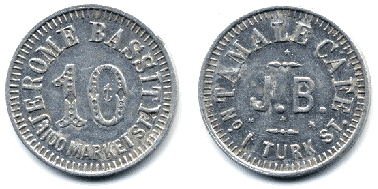
In 1909 Bassity was close to unloading the Mohawk on Col. James M. Wilkins, the respected former proprietor of the third Cliff House whose career began there in 1887. and remaining with Adolph Sutro’s “gingerbread palace” until it was reduced to fire-blackened ruins in 1907. Before the Mohawk deal was to be signed Wilkins - with payment in hand but wary of Bassity’s shady reputation - dropped by the Mohawk to double check the bar’s receipts. It was just as well he did because Bassity had been lying. The Mohawk was in serious money trouble. Wilkins cancelled the deal which led to legal battles over which he prevailed.
The Cliff House
Two brass tokens Wilkins issued for the Cliff House are shown, the first carrying the legend Wilkins & Pearson 5, Cliff House, c.a.klinkner & co. s.f. (21mm) issued in 1895. The other name on the token was for Richmond C. Pearson, a short-lived partner.
The second token (18mm) shows a remarkable image of the third Cliff House and the inscription Good For 10¢ Trade, Drop in Orchestrian (sic). The “Orchestrion” is described in Wikipedia as “a complete wind orchestra with kettle-drums, side drums, cymbals, tambourine and triangle." As a small child I was dragged to the Cliff House by my grandparents and was so scared by the noise that I put hands over my ears and hid my face against my grandmother’s overcoat. A sensitive child.
As concerns Fiedler Bassity’s bulldozer-style, doubtful management skills and notoriety must have made him a problem owner. We can guess with some certainty that Fiedler’s cigar stand was not making money either and that perhaps Fiedler just walked away. By 1910 he was back at his old catering business.
What happened to The Mohawk? Directories show two new proprietors, Joseph T. Ryan and Alfred J. Vlautin as partners for 128 East Street in 1911 and 1912 directories, after that to Vlautin alone.
Bibliography
- Asbury, Herbert, The Barbary Coast: An Informal History of The San Francisco Underworld, Garden City Publishing Co., New York (1933)
- Bevk, Alex, “San Francisco Landmark #7: The Building That Booze Saved” in Curbed San Francisco at https://sf.curbed.com/2014/1/13/10155500/san-francisco-landmark-7-the-building-that-booze-saved (2014)
- California Appellate Decisions, Civil Case No. 829, 3rd Appellate District, September 29, 1911.
- Drexler, Paul, “Jerome Bassity: King of The Tenderloin,” in Crooks Tour of San Francisco at https://www.crookstour.com/purveyors-of-sin/jerome-bassity-king-of-the-tenderloin (April 2018)
- Glover, Eli S., The Illustrated Directory: A Magazine of American Cities Comprising views of Business Blocks with reference to Owners, Occupants, Professions and Trades, Public Buildings and Private Residences, The Illustrated Directory Co., San Francisco, Chicago, New York. E. S. Glover, Manager, 809 Market Street, San Francisco (1896)
- Jacobs, Frank, “San Francisco is Built on a Ghost Ship Graveyard” in Big Think at https://bigthink.com/strange-maps/ghost-ship-map-of-san-francisco (August 9, 2016)
- Kappen, Charles V., California Tokens, The Token and Medal Society, El Cajon CA (1976)
- “Orchestrion” in Wikipedia (2019)
- Riesenberg Jr. Felix, Golden Gate: The Story of San Francisco Harbor, San Francisco (1940)
- Schimmel, Jerry F., “An Old Ship From The Gold Rush” in The Token and Medal Society Journal (April 1993)
- Schimmel, Jerry F., “East Street: The Castle and Castle Branch Saloons” in The Old Streets of San Francisco: Early Street Names on Some Brass Tokens, Pacific Coast Numismatic Society, San Francisco (1993)
- Schimmel, Jerry F., “The Parisian Mansion and Frisco’s Forgotten Resorts of Ill Repute,” in The San Francisco Examiner (December 26, 1994)
- Smallwood, Charles et al, The Cable Car Book, Celestial Arts, Millbrae (1980)
- Sullivan, Jack, Those Pre-Pro Whisky Men: Anson Hotaling of San Fran — God, Whiskey and Fire at http://pre-prowhiskeymen.blogspot.com/2013/03/anson-hotaling-of-san-fran-god-whiskey.html (March 2013)
- San Francisco City and Telephone Directories 1891–1950.
